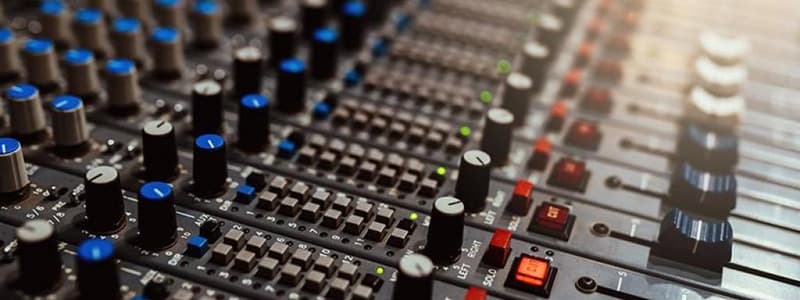Podcast
Questions and Answers
What is the purpose of a de-esser in audio recordings?
What is the purpose of a de-esser in audio recordings?
- To minimize sharp, sibilant sounds (correct)
- To eliminate low-frequency tones
- To enhance the bass frequencies
- To amplify sibilant sounds
Why is the placement of the de-esser before the compressor in the signal chain considered beneficial?
Why is the placement of the de-esser before the compressor in the signal chain considered beneficial?
- It eliminates the need for adjusting male or female settings
- It helps reduce the sibilant sounds before compression (correct)
- It amplifies the sibilant sounds before compression
- It requires less effort to process the sounds
What role does a DSER play in reducing sibilant sounds in male and female voices?
What role does a DSER play in reducing sibilant sounds in male and female voices?
- It adjusts the bass frequencies in female voices
- It amplifies the sibilant sounds in male voices
- It focuses on enhancing the low-frequency tones
- It eliminates specific frequency bands with multiband compressing (correct)
What is the purpose of make-up gain in audio compression?
What is the purpose of make-up gain in audio compression?
How should make-up gain be set in audio compression?
How should make-up gain be set in audio compression?
Why is it important to compress a lead vocal?
Why is it important to compress a lead vocal?
What effect does compressing a lead vocal have?
What effect does compressing a lead vocal have?
In audio compression, what is the effect of incorrectly setting the make-up gain?
In audio compression, what is the effect of incorrectly setting the make-up gain?
What is the role of the threshold in audio compression?
What is the role of the threshold in audio compression?
How does adjusting the threshold affect the compression of an audio signal?
How does adjusting the threshold affect the compression of an audio signal?
In audio compression, what happens when the input signal level exceeds the set threshold?
In audio compression, what happens when the input signal level exceeds the set threshold?
In audio compression, what is the 'knee' referring to?
In audio compression, what is the 'knee' referring to?
What happens when the input signal level exceeds the set threshold in audio compression?
What happens when the input signal level exceeds the set threshold in audio compression?
What is the role of make-up gain in audio compression?
What is the role of make-up gain in audio compression?
Flashcards are hidden until you start studying
Study Notes
- A DSER (De-Esser) is a tool used to minimize sharp, sibilant sounds in audio recordings, particularly those with dominant S, T, F, C, and Z sounds.
- The sharpness of these sounds is influenced by the microphone used and the amount of compression applied to the recording.
- Equalization (EQ) can also amplify these sounds, especially in the 7 kHz region, depending on the vocal quality of the person recorded.
- Most DSERs have one or two functions, depending on the model and brand, allowing users to select male or female settings and adjust certain frequencies.
- They eliminate specific frequency bands using multiband compressing or side chain compressing to reduce the presence of high-frequency tones where sibilant sounds are commonly found.
- Using a compressor followed by a DSER is less effective than putting the DSER before the compressor in the signal chain, as it requires more effort to process the sounds.
- The DSER aims to compress the higher frequency range of an audio recording, eliminating the high-frequency tones where sibilant sounds are most prominent.
- Male and female voices may have different S tone frequencies, so adjusting the DSER settings accordingly can improve the recording quality.
- Using a DSER before a compressor in the signal chain is beneficial as it helps smooth out the sibilant sounds before the compression process begins.
Studying That Suits You
Use AI to generate personalized quizzes and flashcards to suit your learning preferences.




